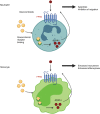Annexin-A1: The culprit or the solution?
- PMID: 35146757
- PMCID: PMC9426623
- DOI: 10.1111/imm.13455
Annexin-A1: The culprit or the solution?
Abstract
Annexin-A1 has a well-defined anti-inflammatory role in the innate immune system, but its function in adaptive immunity remains controversial. This glucocorticoid-induced protein has been implicated in a range of inflammatory conditions and cancers, as well as being found to be overexpressed on the T cells of patients with autoimmune disease. Moreover, the formyl peptide family of receptors, through which annexin-A1 primarily signals, has also been implicated in these diseases. In contrast, treatment with recombinant annexin-A1 peptides resulted in suppression of inflammatory processes in murine models of inflammation. This review will focus on what is currently known about annexin-A1 in health and disease and discuss the potential of this protein as a biomarker and therapeutic target.
Keywords: Annexin-A1; biomarker; cancer; cell signalling inflammation; formyl peptide receptors; immune response.
© 2022 The Authors. Immunology published by John Wiley & Sons Ltd.
Conflict of interest statement
Dr Fiona Dempsey and Scott Crichton are employed by the biopharmaceutical company Medannex, which is working to develop therapeutic antibodies targeting annexin‐A1.
Figures




References
-
- Williams SL, Milne IR, Bagley CJ, Gamble JR, Vadas MA, Pitson SM, et al. A proinflammatory role for proteolytically cleaved Annexin A1 in neutrophil transendothelial migration. J Immunol. 2010;185:3057–63. - PubMed
-
- Vishwanatha JK, Davis RG, Rubinstein I, Floreani A. Annexin I degradation in bronchoalveolar lavage fluids from healthy smokers: A possible mechanism of inflammation. Clin Cancer Res. 1998;4:2559–64. - PubMed
-
- Cheng T‐Y, Wu M‐S, Lin J‐T, Lin M‐T, Shun C‐T, Huang H‐Y, et al. Annexin A1 is associated with gastric cancer survival and promotes gastric cancer cell invasiveness through the formyl peptide receptor/extracellular signal‐regulated kinase/integrin beta‐1‐binding protein 1 pathway. Cancer. 2012;118:5757–67. - PubMed
Publication types
MeSH terms
Substances
LinkOut - more resources
Full Text Sources
Other Literature Sources

